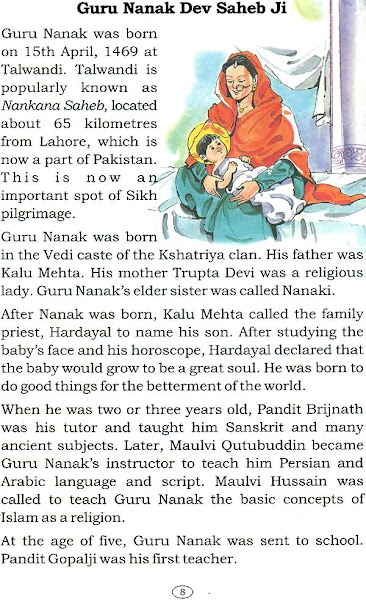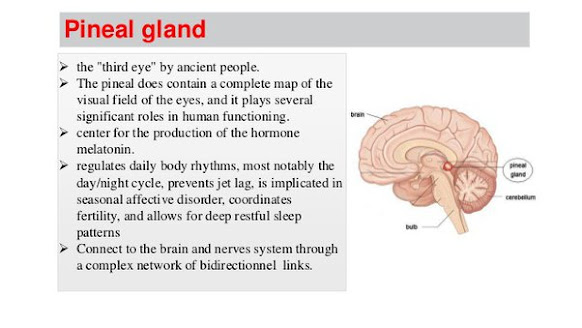SATURDAY
11 June 2022
PINEAL GLAND: SCIENCE & SPIRITUALITY
Pineal Gland is also
called ‘the eye of intuition‘, and it is the doorway through which the
individual enters the astral and psychic dimension of consciousness. Perhaps the most common name for
this chakra is “the third eye”, and the mystical traditions of every age and
culture make abundant references to it. It is portrayed as a psychic eye
located midway between the two physical eyes and it looks inward instead of
outward.” The pineal gland was one of the last brain organs to be discovered
and has been the subject of much mythology and speculation.
What is the pineal gland?
The pineal gland
was described as the “Seat of the Soul” and it is located in the Centre of the
brain. The pineal gland
is a small, pea-shaped gland in the brain. The main function of the pineal
gland is to receive information about the state of the light-dark cycle from
the environment and convey this information to produce and secrete the hormone
melatonin. The rhythmic production of melatonin, secreted only during the dark
period of the day, is extensively used as a marker of the phase of the internal
circadian clock. Melatonin itself is used as a therapy for certain sleep
disorders related to circadian rhythm abnormalities and for the alleviation of
jet lag.
Pineal Anatomy and
Structure
The pineal gland
in humans is a small (100-150mg), highly vascularized, and a secretory
neuroendocrine organ. It is located in the mid-line of the brain called the epithalamus, where the two halves of
the brain join., outside
the blood-brain barrier and attached to the roof of the third ventricle by a
short stalk.
Alternative names for the pineal gland
Pineal body; pineal
organ; epiphysis cerebri; conarium.
Hormones do the pineal gland produce
The major
hormone produced and regulated by the pineal gland is melatonin. Melatonin is
best known for the role it plays in regulating sleep patterns. Sleep patterns
are also called circadian rhythms. The pineal gland also plays a role in the
regulation of female hormone levels, and it may affect fertility and the
menstrual cycle. Melatonin may also help protect against cardiovascular issues
such as atherosclerosis and hypertension. However, more research
needs to be done into the potential functions of melatonin.
Pineal gland & circadian
rhythms
The pineal gland
is key to the body’s internal clock because it regulates the body’s circadian
rhythms. Circadian rhythms (the roughly 24-hour cycle of biological activities
associated with natural periods of light and darkness). are the daily rhythms
of the body, including signals that make someone feel tired, sleep, wake up,
and feel alert around the same time each day? The pineal gland secretes
melatonin, which is a hormone that helps regulate circadian rhythms. Melatonin
is produced according to the amount of light a person is exposed to. The pineal
gland releases greater amounts of melatonin when it is dark, which points to
melatonin’s role in sleep. Serotonin is the precursor of melatonin. Serotonin is acetylated and methylated to yield melatonin within the pineal gland. The
light exposure to the eyes affects the synthesis and secretion of melatonin.
Functions Of Pineal
Gland
Secretion Of Melatonin
This gland secretes
the hormone melatonin which regulates the circadian rhythm of the body and also
certain reproductive hormones. The secretion of this hormone depends upon the
amount of light a person is exposed to. This hormone is produced in large
amounts when it is dark. The presence of light inhibits the secretion of
melatonin which controls our circadian rhythms.
Cardiovascular Health
The melatonin
secretion has a positive impact on the heart and blood pressure. It may also be
used for the treatment of cardiovascular diseases.
Reproduction
Melatonin inhibits
the secretion of reproductive hormones from the anterior pituitary, which are
responsible for the development and functioning of reproductive organs.
Disorders Of Pineal Gland
Listed below are
few disorders caused by the malfunctioning of the pineal gland.
- Depression.
- Mood
swings.
- Peptic
or stomach ulcers.
- Disruption
in sleep patterns.
- An
impaired pineal gland leads to hormonal imbalance.
- Sexual disorders are caused by the dysfunctioning of the pineal gland.
Low melatonin
secretion also leads to anxiety, low thyroid hormone production, menopause
symptoms, etc.
Over secretion of
melatonin can lead to low blood pressure and improper functioning of the thyroid glands and adrenal
glands.
Seasonal affective
disorders of pineal gland include a depressive disorder. This disorder is
mainly caused in the winter season when melatonin secretion is high due to the
presence of low sunlight.
Pineal Gland Controls One’s MoodThis gland was
always recognized as being associated with the agna chakra. Today,
neuroscientists say that the secretions of the pineal gland control and
moderate one's moods and experiences. If you have a very stable and sufficient
pineal secretion, having a pleasant mood within yourself is not a problem. The third eye is believed to
reside within the pineal gland inside of the brain. The name “third eye” comes
from the pineal gland’s primary function of ‘letting in light and darkness’,
just as our two eyes do. Depression patients had smaller pineal parenchymal
volume than healthy controls.
Different
cultures and religions have their own takes on the third eye, but the Hindu
religion is a big proponent of the phenomenon. One of the core Gods, Lord Shiva, possesses a third eye at the center of the forehead which stands for
spiritual knowledge and power.
Pineal Gland is the
Third Eye/Ajna Chakras
The
third eye chakra is an energy center within the body on the forehead in the
center of the brows. It is presumed that we would want all of the chakras in
our bodies to be aligned and properly energized. Once our third eye chakra is
opened, we can gain wisdom, intuition, deeper self-reflection, higher
self-confidence, and logic, just to name a few.
Anyone
would love to have those traits, but you now may be wondering: how does one
open the third eye? A common practice is to do yoga and meditate.
Your
third eye might also be blocked, which prevents you from opening it. A blockage
can cause poor memory, anxiety, and can impair physical, emotional, and mental
health. Modern medicine might suggest that it is blocked due to calcification
of the pineal gland. It can become calcified from fluoride exposure, different
diseases such as Alzheimer’s disease, kidney disease, or an unhealthy
lifestyle. Although pineal gland calcification has been studied, it is not
proven that it can cause medical problems, and you should consult with a doctor
before undergoing any treatments to heal the third eye or pineal gland. The
pineal gland can potentially be healed by using different methods such as
meditation, crystal healing, yoga, exercising, and eating healthy.
Top 3 pineal gland
boosting tips
Purify
Eat clean organic food that have purifying
properties like raw cacao, organic honey, spirulina, zeolite, apple cider
vinegar and vitamin D.
Meditate
By bringing your awareness to the pineal gland
you’ll bring energy to it. Try visualizing an illuminated pineal gland.
The pineal gland is 12cm in from the root of the nose going towards the back of
the head and 5cm up.
Sound
The pineal gland responds to vibration. Humming like a bumble bee creates a beautiful calming vibration to the nervous
system and stimulates the pineal gland. All you need to do is close your
eyes, inhale and on the exhale hum like a bumble bee for 21 breaths.
You’ll feel calm and your mind will feel
refreshed.
Conclusion
The
existence of the pineal gland as third eye or mystic control has been described
in Indian ancient science. The modern world is trending toward the same
inference. Circadian rhythm, its maintenance, and role of melatonin are
important in controlling the normal physiology of the body. Further melatonin
has shown pharmacologic uses as anticancer and antiaging agents. Its role in
preventing osteoporosis and menstrual irregularity is under trials. The author
believes that someday the modern science could decode the mystery of “third
eye” completely, and he intends to find the solution for supernatural controls
also.
Pineal
Gland the third Eye: Where Mysticism Meets Science!










-page-001.jpg)

